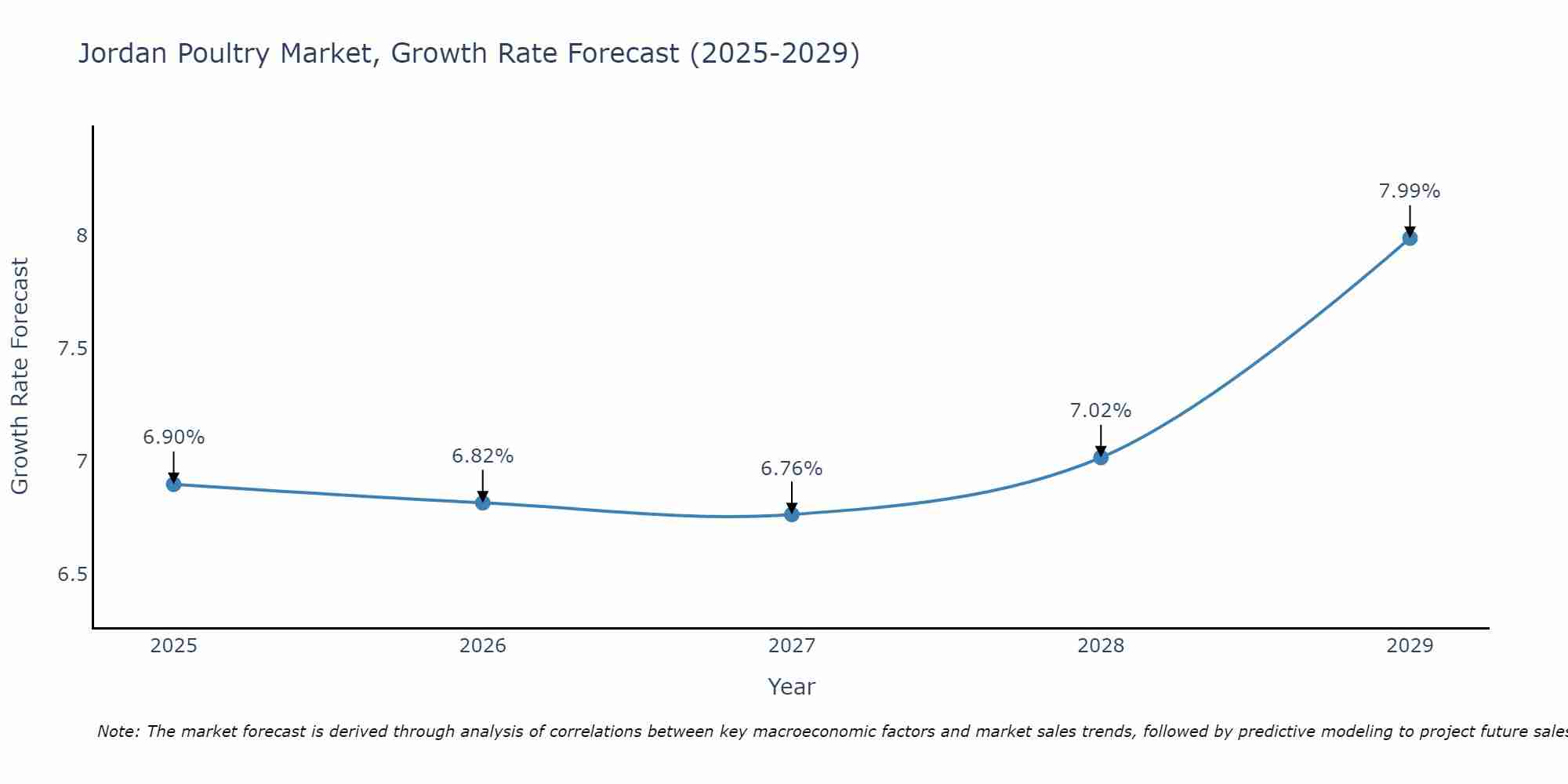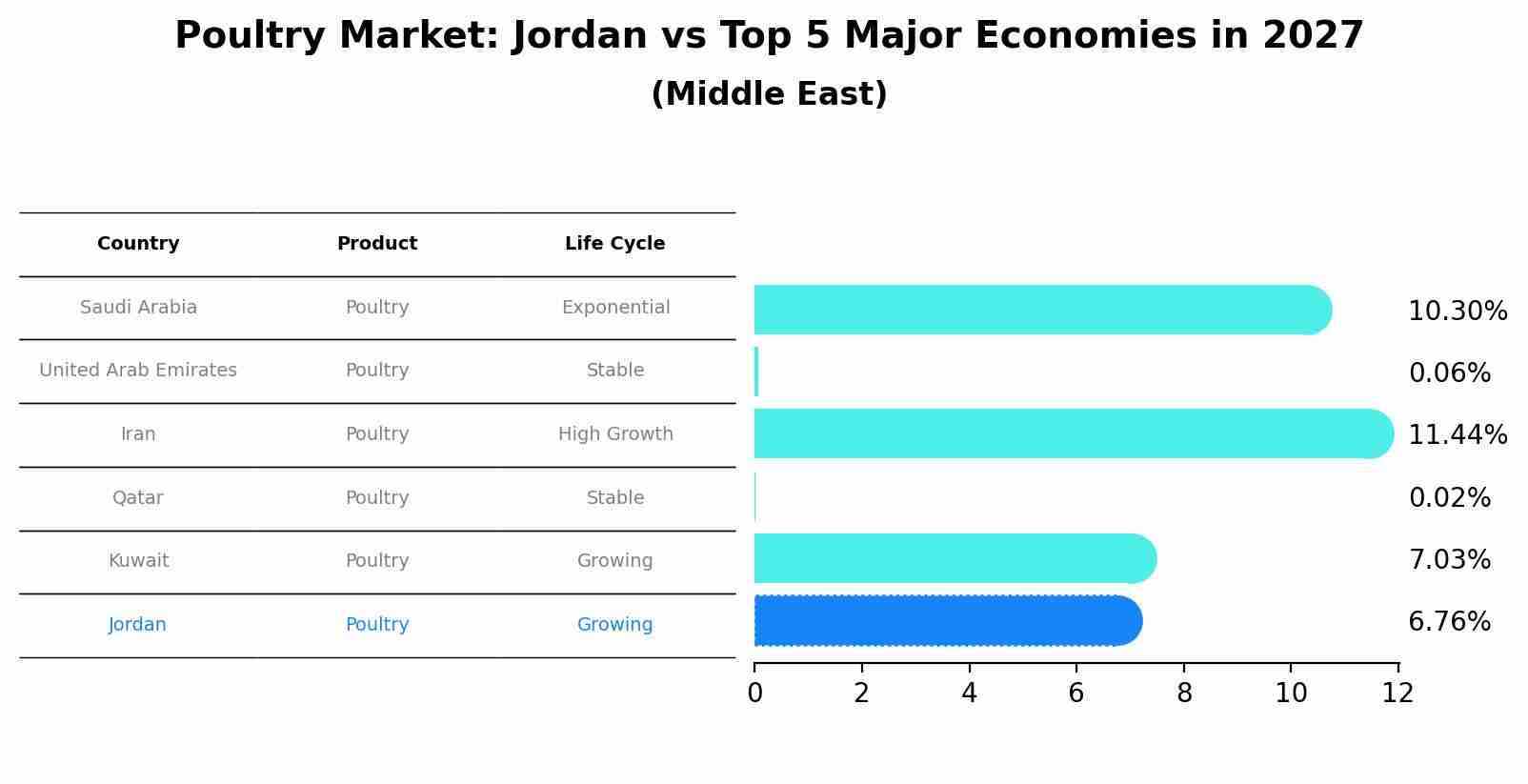Jordan Poultry Market (2025-2031) Outlook | Revenue, Value, Forecast, Companies, Analysis, Industry, Trends, Size, Share, Growth
| Product Code: ETC384226 | Publication Date: Aug 2022 | Updated Date: Jul 2025 | Product Type: Market Research Report | |
| Publisher: 6Wresearch | Author: Dhaval Chaurasia | No. of Pages: 75 | No. of Figures: 35 | No. of Tables: 20 |
Jordan Poultry Market Size Growth Rate
The Jordan Poultry Market is projected to witness mixed growth rate patterns during 2025 to 2029. From 6.90% in 2025, the growth rate steadily ascends to 7.99% in 2029.

Poultry Market: Jordan vs Top 5 Major Economies in 2027 (Middle East)
In the Middle East region, the Poultry market in Jordan is projected to expand at a growing growth rate of 6.76% by 2027. The largest economy is Saudi Arabia, followed by United Arab Emirates, Iran, Qatar and Kuwait.

Jordan Poultry Market Synopsis
The Jordan poultry market is a growing sector fueled by increasing demand for poultry products as a staple in the Jordanian diet. The market is dominated by domestic production, with a focus on broiler chickens, eggs, and turkey. Urbanization, rising disposable incomes, and a shift towards convenient and affordable protein sources are driving the demand for poultry products. Major players in the market include Al-Watania Poultry and other local poultry farms. However, challenges such as disease outbreaks, feed costs, and regulations on imports impact market dynamics. The government plays a significant role in supporting the sector through subsidies, infrastructure development, and regulation. Overall, the Jordan poultry market presents opportunities for growth and innovation driven by changing consumer preferences and government support.
Jordan Poultry Market Trends
In the Jordan poultry market, there is a growing demand for organic and antibiotic-free poultry products as consumers are becoming more health-conscious and concerned about food safety. This trend is driving producers to implement more sustainable and ethical practices in poultry farming. Additionally, there is a rising preference for locally produced poultry to support domestic farmers and reduce reliance on imports. Technology is also playing a significant role in the industry, with the adoption of automation and digital tools to enhance efficiency and productivity in poultry production. Overall, the Jordan poultry market is experiencing a shift towards more sustainable, healthy, and locally sourced poultry products, driven by consumer preferences and advancements in technology.
Jordan Poultry Market Challenges
In the Jordan poultry market, some key challenges include fluctuating feed prices, disease outbreaks, and increasing competition. Fluctuating feed prices, influenced by external factors like weather conditions and global market trends, can significantly impact the profitability of poultry farmers. Disease outbreaks such as avian influenza pose a constant threat to the industry, leading to financial losses and stricter regulations on biosecurity measures. Additionally, the market faces increasing competition from imported poultry products, which can put pressure on local producers to maintain competitive pricing and quality standards. Overall, navigating these challenges requires poultry businesses in Jordan to stay agile, invest in biosecurity measures, and continuously adapt their strategies to remain competitive in the market.
Jordan Poultry Market Investment Opportunities
The Jordan poultry market offers promising investment opportunities due to the country`s high demand for poultry products driven by a growing population and increasing consumer preferences for protein-rich diets. Investors can consider opportunities in poultry farming, processing facilities, and distribution channels to capitalize on the strong market demand. Additionally, advancements in technology and sustainable practices in the poultry industry present avenues for investment in innovative solutions and production methods. Government support for the agricultural sector and potential for export opportunities further enhance the attractiveness of investing in the Jordan poultry market. Overall, investing in the Jordan poultry market can provide a stable and potentially lucrative investment option for those looking to tap into the country`s growing food industry.
Jordan Agar Market Government Policies
The Jordanian government has implemented various policies to support the poultry market in the country. In recent years, the government has focused on ensuring food safety standards, promoting local production, and regulating imports to protect domestic producers. This includes measures such as quality control checks, inspections, and certifications to maintain the standard of poultry products in the market. Additionally, the government provides subsidies and financial support to local poultry farmers to enhance production capacity and competitiveness. Import tariffs and quotas are also in place to regulate the influx of poultry products from foreign markets and safeguard the interests of local producers. Overall, these policies aim to stabilize the Jordanian poultry market, ensure supply security, and support the growth of the domestic poultry industry.
Jordan Poultry Market Future Outlook
The future outlook for the Jordan poultry market appears promising, driven by factors such as increasing consumer demand for poultry products, population growth, and rising disposable incomes. The market is expected to witness steady growth as poultry remains a popular and affordable source of protein for Jordanian consumers. Additionally, advancements in technology and farming practices are likely to improve productivity and efficiency in the poultry industry, leading to increased production levels and competitiveness. However, challenges such as fluctuations in feed prices, disease outbreaks, and regulatory changes may impact market dynamics. Overall, with proper management and strategic investments, the Jordan poultry market is poised for growth and opportunities in the coming years.
Key Highlights of the Report:
- Jordan Poultry Market Outlook
- Market Size of Jordan Poultry Market, 2024
- Forecast of Jordan Poultry Market, 2031
- Historical Data and Forecast of Jordan Poultry Revenues & Volume for the Period 2021 - 2031
- Jordan Poultry Market Trend Evolution
- Jordan Poultry Market Drivers and Challenges
- Jordan Poultry Price Trends
- Jordan Poultry Porter's Five Forces
- Jordan Poultry Industry Life Cycle
- Historical Data and Forecast of Jordan Poultry Market Revenues & Volume By Segments for the Period 2021 - 2031
- Historical Data and Forecast of Jordan Poultry Market Revenues & Volume By Broiler for the Period 2021 - 2031
- Historical Data and Forecast of Jordan Poultry Market Revenues & Volume By Eggs for the Period 2021 - 2031
- Historical Data and Forecast of Jordan Poultry Market Revenues & Volume By End Uses for the Period 2021 - 2031
- Historical Data and Forecast of Jordan Poultry Market Revenues & Volume By Food Service for the Period 2021 - 2031
- Historical Data and Forecast of Jordan Poultry Market Revenues & Volume By Household for the Period 2021 - 2031
- Historical Data and Forecast of Jordan Poultry Market Revenues & Volume By Distribution Channels for the Period 2021 - 2031
- Historical Data and Forecast of Jordan Poultry Market Revenues & Volume By Traditional Retail Stores for the Period 2021 - 2031
- Historical Data and Forecast of Jordan Poultry Market Revenues & Volume By Business To Business for the Period 2021 - 2031
- Historical Data and Forecast of Jordan Poultry Market Revenues & Volume By Modern Retail Stores for the Period 2021 - 2031
- Jordan Poultry Import Export Trade Statistics
- Market Opportunity Assessment By Segments
- Market Opportunity Assessment By End Uses
- Market Opportunity Assessment By Distribution Channels
- Jordan Poultry Top Companies Market Share
- Jordan Poultry Competitive Benchmarking By Technical and Operational Parameters
- Jordan Poultry Company Profiles
- Jordan Poultry Key Strategic Recommendations
Frequently Asked Questions About the Market Study (FAQs):
- Single User License$ 1,995
- Department License$ 2,400
- Site License$ 3,120
- Global License$ 3,795
Search
Thought Leadership and Analyst Meet
Our Clients
Related Reports
- Germany Breakfast Food Market (2026-2032) | Industry, Share, Growth, Size, Companies, Value, Analysis, Revenue, Trends, Forecast & Outlook
- Australia Briquette Market (2025-2031) | Growth, Size, Revenue, Forecast, Analysis, Trends, Value, Share, Industry & Companies
- Vietnam System Integrator Market (2025-2031) | Size, Companies, Analysis, Industry, Value, Forecast, Growth, Trends, Revenue & Share
- ASEAN and Thailand Brain Health Supplements Market (2025-2031) | Strategy, Consumer Insights, Analysis, Investment Trends, Opportunities, Growth, Size, Share, Industry, Revenue, Segments, Value, Segmentation, Supply, Forecast, Restraints, Outlook, Competition, Drivers, Trends, Demand, Pricing Analysis, Competitive, Strategic Insights, Companies, Challenges
- ASEAN Bearings Market (2025-2031) | Strategy, Consumer Insights, Analysis, Investment Trends, Opportunities, Growth, Size, Share, Industry, Revenue, Segments, Value, Segmentation, Supply, Forecast, Restraints, Outlook, Competition, Drivers, Trends, Demand, Pricing Analysis, Competitive, Strategic Insights, Companies, Challenges
- Europe Flooring Market (2025-2031) | Outlook, Share, Industry, Trends, Forecast, Companies, Revenue, Size, Analysis, Growth & Value
- Saudi Arabia Manlift Market (2025-2031) | Outlook, Size, Growth, Trends, Companies, Industry, Revenue, Value, Share, Forecast & Analysis
- Uganda Excavator, Crane, and Wheel Loaders Market (2025-2031) | Strategy, Consumer Insights, Analysis, Investment Trends, Opportunities, Growth, Size, Share, Industry, Revenue, Segments, Value, Segmentation, Supply, Forecast, Restraints, Outlook, Competition, Drivers, Trends, Demand, Pricing Analysis, Competitive, Strategic Insights, Companies, Challenges
- Rwanda Excavator, Crane, and Wheel Loaders Market (2025-2031) | Strategy, Consumer Insights, Analysis, Investment Trends, Opportunities, Growth, Size, Share, Industry, Revenue, Segments, Value, Segmentation, Supply, Forecast, Restraints, Outlook, Competition, Drivers, Trends, Demand, Pricing Analysis, Competitive, Strategic Insights, Companies, Challenges
- Kenya Excavator, Crane, and Wheel Loaders Market (2025-2031) | Strategy, Consumer Insights, Analysis, Investment Trends, Opportunities, Growth, Size, Share, Industry, Revenue, Segments, Value, Segmentation, Supply, Forecast, Restraints, Outlook, Competition, Drivers, Trends, Demand, Pricing Analysis, Competitive, Strategic Insights, Companies, Challenges
Industry Events and Analyst Meet
Whitepaper
- Middle East & Africa Commercial Security Market Click here to view more.
- Middle East & Africa Fire Safety Systems & Equipment Market Click here to view more.
- GCC Drone Market Click here to view more.
- Middle East Lighting Fixture Market Click here to view more.
- GCC Physical & Perimeter Security Market Click here to view more.
6WResearch In News
- Doha a strategic location for EV manufacturing hub: IPA Qatar
- Demand for luxury TVs surging in the GCC, says Samsung
- Empowering Growth: The Thriving Journey of Bangladesh’s Cable Industry
- Demand for luxury TVs surging in the GCC, says Samsung
- Video call with a traditional healer? Once unthinkable, it’s now common in South Africa
- Intelligent Buildings To Smooth GCC’s Path To Net Zero


















